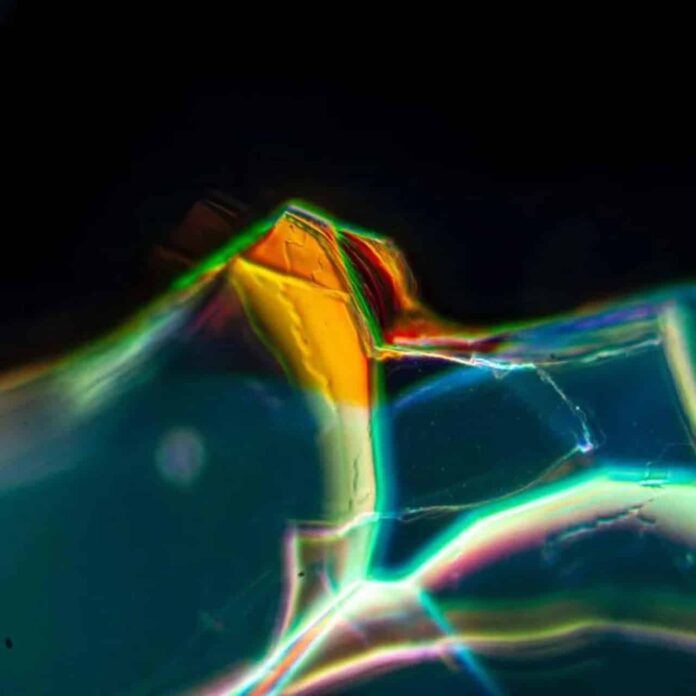Ancient glass objects typically show distinctive deterioration effects due to environmentally induced physicochemical transformations of their surface over time. Iridescence is one of the distinctive aging signatures most commonly found on excavated glass.
In a new study, scientists presented an ancient glass fragment that exhibits structural color through surface weathering, resulting in iridescent patinas caused by silica reprecipitation in nanoscale lamellae.
These glass fragments were uncovered from construction sites and archaeological digs. They reveal themselves to be something extraordinary. On their surface is a mosaic of iridescent blue, green, and orange colors, with some displaying shimmering gold-colored mirrors.
These beautiful glass artifacts are often set in jewelry as pendants or earrings, while larger, more complete objects are displayed in museums.
These beautiful glass artifacts are often set in jewelry as pendants or earrings, while larger, more complete objects are displayed in museums.
Fiorenzo Omenetto and Giulia Guidetti, professors of engineering and materials scientists at Tufts University Silklab, find it fascinating how the molecules in the glass rearranged and combined with minerals over thousands of years to form what are known as photonic crystals, which are ordered arrangements of atoms that filter and reflect light in very specific ways.
In this study, scientists reported unique atomic and mineral structures built from the glass’s original silicate and mineral constituents. What’s more, these structures were modulated by the surrounding environment’s pH and the fluctuating groundwater levels in the soil.
Omenetto said, “This beautiful sparkling piece of glass on the shelf attracted our attention. It was a fragment of Roman glass recovered near the ancient city of Aquileia, Italy.”
Arianna Traviglia, director of the Center, said her team referred to it affectionately as the ‘wow glass.’
When scientists closely observed, they realized they were naturally looking at the nanofabrication of photonic crystals.
Omenetto said, “It’s remarkable that you have glass that is sitting in the mud for two millennia, and you end up with something that is a textbook example of a nanophotonic component.”
The glass shard was chemically dated by the IIT team from the first century BCE to the first century CE, with beginnings in the Egyptian sands – a sign of widespread commerce. While the surface of the shard had a millimeter-thick patina with an almost flawless mirror-like gold reflection, most of it still had its original dark green hue. A novel type of scanning electron microscope was employed by Omenetto and Guidetti that not only displays the material’s structure but also gives an elemental analysis.
Guidetti said, “Basically it’s an instrument that can tell you with high resolution what the material is made of and how the elements are put together.”
They determined that the patina had a hierarchical structure of extremely regular, micrometer-thick layers of silica that alternated between high and low density, like Bragg stack reflectors. Each Bragg stack significantly reflected different, rather narrow wavelengths of light. The patina looked like a golden mirror due to the vertical stacking of tens of Bragg stacks.
How did this building evolve? The researchers propose a potential mechanism that has slowly operated for centuries.
Guidetti said, “This is likely a process of corrosion and reconstruction. The surrounding clay and rain determined the diffusion of minerals and the cyclical corrosion of the silica in the glass. At the same time, the assembly of 100 nanometer-thick layers combining the silica and minerals also occurred in cycles. The result is an incredibly ordered arrangement of hundreds of layers of crystalline material.”
Omenetto added, “While the age of the glass may be part of its charm, in this case, if we could significantly accelerate the process in the laboratory, we might find a way to grow optic materials rather than manufacture them.”
There are some similarities between the molecular cycle of destruction and regeneration and the history of Rome. Aqueducts, highways, amphitheaters, and temples were a few of the long-lasting constructions the ancient Romans enjoyed building. These buildings later served as the base for the city’s topography.
Since then, the city has expanded in layers due to wars, social upheavals, and the passage of time, with buildings rising and collapsing due to these changes. In the Middle Ages, materials from damaged and abandoned historic structures were utilized to build new structures. Modern streets and structures are frequently constructed on top of old foundations.
Journal Reference:
- Giulia Guidetti, Roberta Zanini et al. Photonic crystals were built by time in ancient Roman glass. PNAS. DOI: 10.1073/pnas.2311583120
